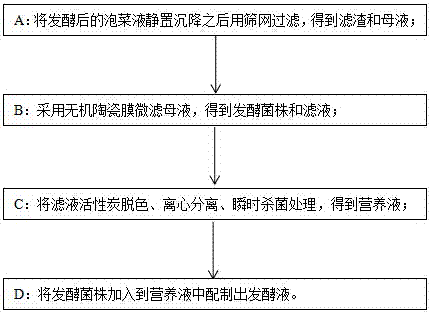Method for recycling secondary fermentation pickle pickling liquid
A technology of secondary fermentation and liquid circulation, applied in the field of food processing, can solve the problems of easy infection of miscellaneous bacteria, pollution, waste, etc., and achieve the effect of achieving sustainable development, optimizing fermentation methods, and avoiding waste of resources
- Summary
- Abstract
- Description
- Claims
- Application Information
AI Technical Summary
Problems solved by technology
Method used
Image
Examples
Embodiment 1
[0019] combine figure 1 The embodiment is described, the second fermentation pickle pickling liquid is processed, first the fermented pickle liquid is left to settle to obtain a clarified liquid, and then filtered with a 200-mesh sieve to obtain a filter residue and a mother liquor; the obtained filter residue can be used For the preparation of life condiments. Use high-temperature steam to sterilize the alumina inorganic ceramic membrane, keep it at 120°C for 25 minutes, the pore size of the alumina inorganic ceramic membrane is 3um; filter the mother liquor with the alumina inorganic ceramic membrane, the filtration pressure is 0.15MPa, and the filtration time is 60min. Fermentation strains and filtrates were obtained. The obtained filtrate is decolorized with activated carbon, then sterilized at high temperature instantaneously, and the nutrient solution is obtained through centrifugation at a speed of 2000rmp; the obtained fermentation strain is expanded, and then added t...
Embodiment 2
[0022] The secondary fermented kimchi pickling liquid is processed, first, the fermented kimchi liquid is left to settle to obtain a clarified liquid, and then filtered through a 300-mesh sieve to obtain filter residue and mother liquor; the obtained filter residue can be used to prepare life condiments. Use high-temperature steam to sterilize the alumina inorganic ceramic membrane, keep it at 130°C for 20 minutes, the pore size of the silica inorganic ceramic membrane is 2um; filter the mother liquor with the alumina inorganic ceramic membrane, the filtration pressure is 0.15MPa, and the filtration time is 60min. Fermentation strains and filtrates were obtained. The obtained filtrate is decolorized with activated carbon, centrifuged at 2500rmp, and then sterilized at high temperature instantaneously to obtain a nutrient solution; the obtained fermentation strain is expanded, and then added to the nutrient solution to prepare a salinity of 6% and a pH value of 6.2 fermented li...
Embodiment 3
[0025] The secondary fermented kimchi pickling liquid is processed, first, the fermented kimchi liquid is left to settle to obtain a clarified liquid, and then filtered through a 300-mesh sieve to obtain filter residue and mother liquor; the obtained filter residue can be used to prepare life condiments. Disinfect and sterilize the alumina inorganic ceramic membrane by high-temperature steam method, keep it at 130°C for 20 minutes, and the pore size of the silica inorganic ceramic membrane is 0.15um; filter the mother liquor with the silica inorganic ceramic membrane, the filtration pressure is 0.2MPa, and the filtration time is 45min , to obtain the fermentation strain and the filtrate. The obtained filtrate is decolorized with activated carbon, centrifuged at 2500rmp, and then sterilized at a high temperature to obtain a nutrient solution; the obtained fermentation strain is expanded, and then added to the nutrient solution to prepare a salinity of 4% and a pH value of 6.4 f...
PUM
 Login to View More
Login to View More Abstract
Description
Claims
Application Information
 Login to View More
Login to View More - R&D
- Intellectual Property
- Life Sciences
- Materials
- Tech Scout
- Unparalleled Data Quality
- Higher Quality Content
- 60% Fewer Hallucinations
Browse by: Latest US Patents, China's latest patents, Technical Efficacy Thesaurus, Application Domain, Technology Topic, Popular Technical Reports.
© 2025 PatSnap. All rights reserved.Legal|Privacy policy|Modern Slavery Act Transparency Statement|Sitemap|About US| Contact US: help@patsnap.com

